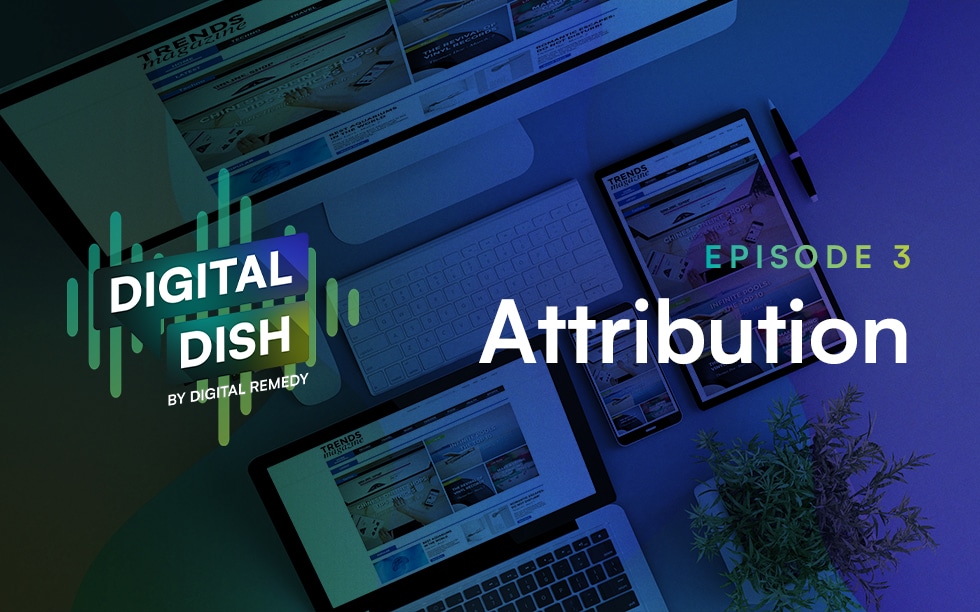Apr 13, 2023
Welcome to the third episode of The Digital Dish, where we dish on all things ad tech! This episode focuses on attribution, including an overview of what it is, what the industry challenges are, the pros and cons of four different types of methodologies, and best practices for maximizing your media strategy. Prefer to read? Here’s…

Welcome to the third episode of The Digital Dish, where we dish on all things ad tech! This episode focuses on attribution, including an overview of what it is, what the industry challenges are, the pros and cons of four different types of methodologies, and best practices for maximizing your media strategy.
Prefer to read? Here’s the transcript:
This series topic is attribution. The digital age has brought a wealth of opportunity for businesses of all sizes. With that opportunity comes a new set of challenges, among them attribution.
Attribution, or the process of determining which channels are driving customer behavior, has always been important for businesses, and in this age, it’s more important than ever. With so many channels and so much noise, it’s more difficult to determine which channels are actually driving sales and conversions.

In this episode of the Digital Dish, we’ll look at:
What we know is that all media strategies are tied to outcomes. Whether your brand is looking to measure engagement or actual direct response, you need to know whether you are getting a return on your investment. It’s likely that as a marketer, you are running a combination of media and need to track the sources of your traffic and leads to determine what is and isn’t working.

This is where attribution comes in. While attribution isn’t always easy to understand, it is crucial. It’s hard to track a customer’s journey:
But ultimately, you do need to know what the customer journey was (from start to finish) and understand which channels played a part in the consumer’s journey to buy or engage with your product or service.
There are a LOT of attribution models out there, so today, we are going to uncover some truths and simplify them for you.
So why measure? Why is attribution so important? Well, to start, you can’t improve what you don’t measure. By tracking the success (or lack thereof) of your marketing efforts, you can determine what’s working and what’s not. And that knowledge will help you allocate your resources more effectively in the future, working towards the goal of increasing overall ROI.
The most common methodology you’ll hear of is the last-touch model of attribution. The flaw here is that last touch refers to just that – the last touch point a customer had interacted with before making a purchase. This isn’t always accurate, however, since we are all subject to so many screens, shared screens, and innumerable distractions. The single-user journey just isn’t the case anymore.
For example, if a customer sees a social media ad, hears an audio ad, and then sees a display ad that they click on and finally make a purchase, the social and audio ad would not receive credit in the last touch attribution model.
That’s why it’s important to use more than one attribution model. By using multiple models, you can get a more accurate picture of how your marketing is performing and where you need to make adjustments.
Now we’re going to review four attribution methodologies, as well as their pros and cons, so you can be informed and ultimately choose the right one for your business. So, what are they?
Let’s first start with last touch methodology, which is the most commonly used. Last touch refers to the last touch point a customer had interacted with before making a purchase and therefore giving this last touch point the entire conversion credit.


The single-user journey just isn’t the case anymore. If you are working with a long buying cycle or want to understand how the consumer goes from the initial brand awareness stage through the funnel to becoming a customer or user, this methodology isn’t for you.
The next is first touch methodology, which is the opposite of last touch. With first touch, the first time that a customer interacts with your company that is determined the most important reason they ended up purchasing with you.

Next up, we have linear attribution, which is a multi-touch model–meaning it takes into account and attributes credit to multiple touchpoints along the customer journey. In fact, this model actually takes into account every single interaction that a prospect has had with your brand prior to purchasing. This method is incredibly easy to understand as every single touchpoint is given the same amount of credit, so the equation is as follows:
100% of the overall credit / the number of touchpoints in the conversion path = the amount of credit per touchpoint
For example, if your customer has four interactions with your brand before deciding to convert, each would, therefore, have 25% of the credit.

Finally, there’s time decay attribution. This is similar to linear in that it’s a multi-touch model that gives some credit to all channels that led to the conversion. However, this is different with that amount of credit being less (or “decaying”) the further back in time the channel was interacted with. This assumes that the first channel your customer interacted with merely planted the seed, and the customer’s interest in committing to a purchase grew over time with repeated exposure to various marketing channels. Think of this as a rising level of interest and commitment from the customer over time.

Now that we can understand what attribution is and the different methodologies you can consider, the next step is to review your current strategies to see which ones are working and which ones need improvement. Here are a few tips to help you master attribution in the digital age:

Use a consistent methodology across all channels and platforms. This involves creating benchmark goals and making sure that all channels are performing according to those standards.
Set up advanced tracking capabilities, such as key conversion pixels on high-traffic landing pages or mobile app tracking for detailed insights. Having multiple data points will help you pinpoint any weaknesses in your attribution model and make timely adjustments.
Be proactive in finding ways to increase return on investment from existing channels. You don’t want to track just performance; rather, you should continually seek out ways to improve results through optimization techniques such as A/B testing or identifying new audiences with demographic data. If you are a brand or agency with a goal to understand which touchpoint or variable along the consumer path is driving conversions and in the past have been directed to a single touch model, for example (like last or first touch), start thinking outside of that assumed-consumer path and consider a methodology that would best suit your specific set of challenges.
Leveraging these best practices and taking advantage of the latest technologies, as well as our custom attribution guidance, will help you master each methodology and create a more sophisticated strategy to drive best results.
As technology advances, so too does our ability to measure and optimize attribution. Thanks to powerful data visualization tools, machine learning algorithms, and the ever-growing volume of available customer data, marketers now have access to a wealth of insights when it comes to understanding where each consumer interaction is coming from.
Detail is key here, with the right technology, we can analyze granular data about each marketing initiative – including specific channels, campaigns, and even individual creatives – to understand how each variable impacts your customer journey and overall bottom line. Our full-funnel attribution methodologies help all advertisers across all verticals make better decisions about which tactics are most effective for driving results, wherever they may lie in the marketing funnel.
Take an example that we recently worked on with a DTC e-commerce brand. They had a digital strategy spanning multiple channels, from Performance CTV to Podcasts, Social, and Display Retargeting, and it was becoming increasingly difficult to equate purchases to any one variable and, thus, hard to dedicate specific spend to any one channel.
Both the first and last touch methodologies were not a suitable solution for this client, as they were new to market, had a higher price point of goods, and a longer sales cycle. It meant that typically, a customer interacted with media multiple times across multiple channels before making a purchase. Our team at Digital Remedy assessed every impression of this campaign and provided traceable data correlating each impression to a conversion, whether that was an online purchase, homepage visit, or email sign up. This full-funnel data allowed us to flag variables that were significant in the customer journey and therefore recommend the allocation of higher spend to these channels, and ultimately drive down the CPA for this client.
Attribution is a core digital marketing function, and it’s more complex than most people realize. It’s not just about correctly identifying the channels that drove a conversion but also understanding how each channel works together to influence conversions and from there, determining the most effective allocation of dollars and resources.
Getting attribution right is essential for optimizing your return on investment. With these data sets and insights, you can make more informed decisions about where to allocate your budget, and which channels are most likely to drive down cost per acquisition.
The digital landscape is constantly evolving, and it’s crucial that, as marketers, we stay ahead of the curve and master the art of attribution. With the right tools and knowledge, you can make sure your marketing efforts are always working as hard as they can to drive conversions and growth. Think of attribution as step one. Once we get that right, we can build upon its foundation with specialized optimization, incrementality, and halo effect methodologies.
Interested in learning more? Check out our Trends & Insights report—or speak to a team member! Be sure to follow Digital Remedy on LinkedIn, Twitter, and Instagram for the latest updates.
Related Posts

In the constantly evolving digital advertising landscape, agility and flexibility are paramount. As agencies and advertisers look to maximize.

When COVID-19 upended the world in early 2020, the ripple effects were swift and far-reaching across every industry, and.

As artificial intelligence continues to dominate headlines and industry conversations, confusion still lingers—especially around the relationship between artificial intelligence.